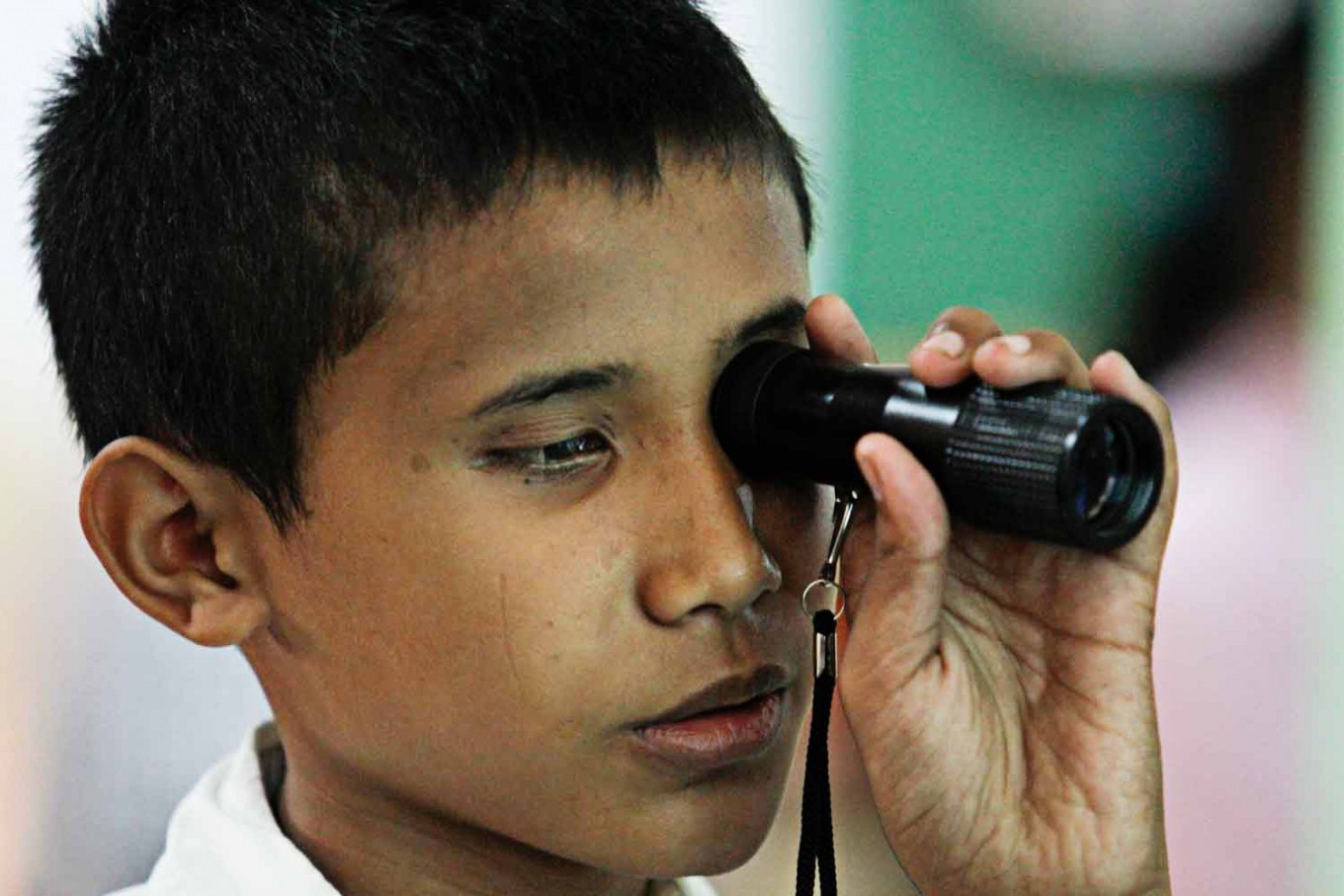Bandung Low Vision Center in dire need of eyesight tools
Change Size
 ‘I can see clearly now’ – Mohammad Irfan, 12, uses a telescope to read from a long range during the launch of the Low Vision Center at the Syamsi Dhuha Foundation secretariat in Bandung, West Java, recently. Eyesight tools needed by people with poor vision are mostly imported from China and India. (thejakartapost.com/Arya Dipa)
‘I can see clearly now’ – Mohammad Irfan, 12, uses a telescope to read from a long range during the launch of the Low Vision Center at the Syamsi Dhuha Foundation secretariat in Bandung, West Java, recently. Eyesight tools needed by people with poor vision are mostly imported from China and India. (thejakartapost.com/Arya Dipa)
G
erry brought a small telescope closer to his right eye and looked at the objects in front of him. Later, he put the telescope to his left eye. He tried several black telescopes with lengths of less than 20 centimeters before he chose a telescope with a 10-fold-enlargement capacity.
“Can you see clearly? Are you sure this telescope is most comfortable for you?” Gerry’s father, Yuyus Bekoming, 47, asked. He wanted to make sure that his son made the right choice on an eyesight tool during their visit to the Low Vision Center in Bandung, West Java, recently.
Gerry started having vision problems after finishing elementary school. Yuyus said he became suspicious that Gerry had poor vision when his second child started sitting very close to the TV to watch programs. “He always sits about a meter from the TV. It has a 42-inch screen,” said Yuyus.
After taking his son to ophthalmologists in Indonesia and abroad for an eye check, Yuyus eventually learned there were problems with Gerry’s optic nerve, which connects the eyes to the brain. According to the ophthalmologists, Gerry’s eyes were in a healthy condition.
“His vision continued to deteriorate from 30 percent to around 5 percent,” said Yuyus. Relentlessly, he kept striving to seek technology and ophthalmologists who could help improve his son’s sight.
Yuyus said eyesight tools such as telescopes were important for Gerry, who wanted to steep himself in information and technology.
“That’s why we have also prepared a magnifier to help him read. Fortunately, he goes to an inclusive state school. This is another aspect that us really helpful for our son,” said Yuyus, referring to Gerry’s school, SMA 54 state senior high school in Jakarta.
Syamsi Dhuha Foundation founder Dian Syarief said not all people with poor vision could afford to buy eyesight tools as they were costly. “For magnifying glasses, it is still affordable because it costs no more than Rp 100,000 [US$7.52]. But a telescope costs up to Rp 400,000 while an electric magnifier costs millions of rupiah. They are quite expensive because most of them are imported,” said Dian.
The Syamsi Dhuha Foundation, a non-profit organization focusing on low vision, has launched the Low Vision Center, which is an expansion of its Care for Low Vision program. The program has been running since the Syamsi Dhuha Foundation was established in 2004.
“From the very beginning, we have carried out low vision-related education and research activities and introduced them to the public. As we have been given certainty as to the availability of eyesight tools for people with low vision, we launched the Low Vision Center,” said Dian.
She aimed to develop the Low Vision Center to become an institution that supports research for the development and modification of low vision tools. It is hoped that the research and development activities will be conducted mainly by Indonesians and help reduce the need to import eyesight tools for low vision patients.
Syamsi Dhuha Foundation manager Laila Pancasari said every person who wanted to access an eyesight tool could donate to the Low Vision Center. “We purchase all eyesight tools available in the center using donations so it is expected that everyone who takes a tool donates so we can make sure there is an available supply of eyesight tools,” said Laila.
To support the procurement of the low vision tools, the Syamsi Dhuha Foundation is working with several partners, such as Cicendo National Eye Center, eye center Mitra Netra, Yayasan Penyantun Wyata Guna for the disabled, Universe Awareness for Children Indonesia, education institution Biomedika at the Bandung Institute of Technology and the West Java Education Agency.
Dian said poor vision could hamper anyone regardless of age. The causes of poor vision include birth defects, accidents, macula degenerative illness in old age and other problems such as cataract, glaucoma, infection and much more.
People who have difficulty seeing things at close range have problems reading and writing, maintaining personal hygiene, choosing clothes to wear and donning them and eating and drinking. They also face difficulty working on detailed activities related to certain professions, such as sewing, sculpturing and much more.
Meanwhile, people with limited vision will face difficulty looking for objects. Their mobility will be disrupted each time the light exposure level changes or each time they are in a strange place or in a crowded location, such as at a party or in a market.
“Low vision is not the end of everything. There is always hope if we have a willingness to maximize the remaining vision capacity by making some adaptations,” said Dian. (ebf)









